
The Flora
A fascinating plant paradise
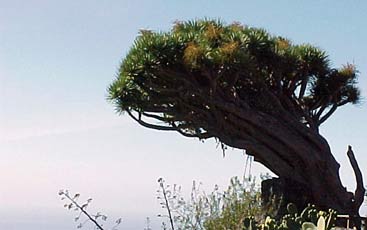
- A Dragon Tree, spanish: Drago
Thanks to its climate, geographical location and different altitudes, La Palma has several vegetation zones with a rich flora, including numerous endemic species that are found only on the Canary Islands and, in some cases, exclusively on La Palma.
Endemic: only available in a certain area
The Dragon Tree
Canary Islands' legendary natural heritage
The dragon tree (Spanish: Drago) is a botanical landmark of the Canary Islands and is frequently found on La Palma. Only on this island there are still numerous specimens growing in the wild, some of them very old, which are up to 20 m high. In some areas they form small groves, which integrate themselves into the landscape in a wild and romantic way. The Drago is not a conventional tree, but belongs to the genus of lily trees. The natives worshipped him as a saint and used the juice of his bark as medicine. Thanks to its unusual shape, it has an almost magical appeal to this day.
The Palms and Succulents
Exotic plants in the wild
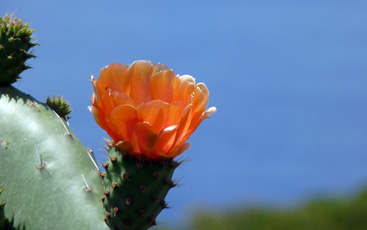
- Cactus Flower
As a native species, the Canary Island date palm (Phoenix canariensis) is particularly noteworthy among the palm trees, which have spread worldwide due to their popularity. It is closely related to the North African date palm and has a massive stocky trunk with a dense crown of long dark green fronds. The landscape of the dry and warm regions is dominated by succulents. Among them are many plants of spurge, such as the endemic candelabre spurge, which reminds of a cactus on the outside, or the Tabaiba. Once introduced from Central America, the fig cacti, with their edible fruits, and agaves have multiplied numerously.
The Forests of La Palma
Evergreen cloud primeval forest and sun-drenched pine forests
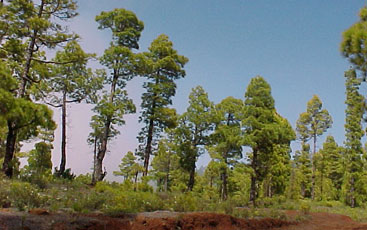
- Light Flooded Pine Forest above Puntagorda
The original laurel forest of La Palma is considered to be the oldest and best preserved primeval forest in Europe. A laurel tree can reach a height of up to 30 m and impresses not only by its species-rich tree population but also by its lush undergrowth with huge ferns, lichens, mosses, mushrooms and herbs. At higher altitudes of 1000 m, the laurel forest merges into the light pine forests, which consist almost exclusively of the Canarian pine (Pinus canariensis) and occupy the largest area of vegetation. Its long needles collect (condensate) the water from the clouds, which then flows into the groundwater and makes a decisive contribution to the island's water wealth. In earlier times, the pine was a popular building material. For example, large areas were cut down to build ships and houses. Thanks to a reforestation programme, it has been able to spread widely again to this day.
The light pine forests grow at an altitude between 1000 and 2000 meters. After this tree line, only a few species can survive, such as the Teide broom, isolated firetrees or the low Codesco shrub with its yellow flowers.
Cultivated and Ornamental Plants
The Garden of Eden - a sea of flowers all year round
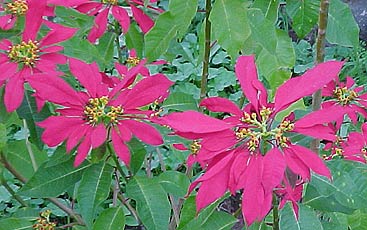
- Winter Rose can Grow Tree-sized on La Palma
The Spanish conquerors brought a wealth of exotic ornamental and useful plants to the island. In addition to the above-mentioned fig cacti and agaves, giant poinsettias, hibiscus, colourful bougainvillea, oleander and the popular bird of paradise, also known as strelitzie, here. Agricultural land includes almond and fruit trees, vegetables, tobacco and vines, and above all bananas, which are the most important crops and cover large parts of the coastal regions.
The Fauna
Living space for a colourful society
The fauna of La Palma is also home to many endemic species.
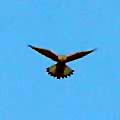
- Falcon Hunting
Birds - Numerous bird species can be found here, such as the blue tit, the chaffinch, blackbird, pigeon, common swifts, various sea birds and the wild canary bird. The endemic species also include the bat and the black feathered crow (span. Graja) with her red beak and unmistakable sounds. Most of the time they appear in large swarms and provide an impressive spectacle for a short time. The kestrel is often seen looking for food and spinning his rounds. Other birds of prey are the buzzard and the owl.
Insects - The insect world is home to dragonflies and a wealth of butterflies such as the cabbage white butterfly, the admiral or the brimstone butterfly. Numerous bee colonies form the basis for the delicious honey of La Palma. A species of centipedes introduced from South America has spread throughout the island. It is non-toxic and not dangerous.
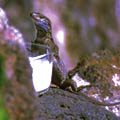
- Lizard
Reptiles - Among the reptiles there are different kinds of lizards, which can be up to 20 cm long. With a bit of luck you get to see the geckos at night, who like to stay in the houses and are considered lucky charms.
Land Animals - Other land animals are wild rabbits, mouflons and wild dogs. Among the usual domestic and farm animals, in addition to sheep and cattle, the goat is particularly noteworthy.
Marine life - The marine fauna includes many species of fish and marine life. Moray eels, tunas, perch, rays and sepias are just a few of them. Outside the coastal zone there are schools of dolphins, 26 species of whales and occasionally sharks.
